- Home
- Walter Isaacson
Walter Isaacson Great Innovators e-book boxed set Page 17
Walter Isaacson Great Innovators e-book boxed set Read online
Page 17
One of the new engineers interrupted and asked why it mattered. “The only thing that’s important is how well it works. Nobody is going to see the PC board.”
Jobs reacted typically. “I want it to be as beautiful as possible, even if it’s inside the box. A great carpenter isn’t going to use lousy wood for the back of a cabinet, even though nobody’s going to see it.” In an interview a few years later, after the Macintosh came out, Jobs again reiterated that lesson from his father: “When you’re a carpenter making a beautiful chest of drawers, you’re not going to use a piece of plywood on the back, even though it faces the wall and nobody will ever see it. You’ll know it’s there, so you’re going to use a beautiful piece of wood on the back. For you to sleep well at night, the aesthetic, the quality, has to be carried all the way through.”
From Mike Markkula he had learned the importance of packaging and presentation. People do judge a book by its cover, so for the box of the Macintosh, Jobs chose a full-color design and kept trying to make it look better. “He got the guys to redo it fifty times,” recalled Alain Rossmann, a member of the Mac team who married Joanna Hoffman. “It was going to be thrown in the trash as soon as the consumer opened it, but he was obsessed by how it looked.” To Rossmann, this showed a lack of balance; money was being spent on expensive packaging while they were trying to save money on the memory chips. But for Jobs, each detail was essential to making the Macintosh amazing.
When the design was finally locked in, Jobs called the Macintosh team together for a ceremony. “Real artists sign their work,” he said. So he got out a sheet of drafting paper and a Sharpie pen and had all of them sign their names. The signatures were engraved inside each Macintosh. No one would ever see them, but the members of the team knew that their signatures were inside, just as they knew that the circuit board was laid out as elegantly as possible. Jobs called them each up by name, one at a time. Burrell Smith went first. Jobs waited until last, after all forty-five of the others. He found a place right in the center of the sheet and signed his name in lowercase letters with a grand flair. Then he toasted them with champagne. “With moments like this, he got us seeing our work as art,” said Atkinson.
CHAPTER THIRTEEN
BUILDING THE MAC
The Journey Is the Reward
Competition
When IBM introduced its personal computer in August 1981, Jobs had his team buy one and dissect it. Their consensus was that it sucked. Chris Espinosa called it “a half-assed, hackneyed attempt,” and there was some truth to that. It used old-fashioned command-line prompts and didn’t support bitmapped graphical displays. Apple became cocky, not realizing that corporate technology managers might feel more comfortable buying from an established company like IBM rather than one named after a piece of fruit. Bill Gates happened to be visiting Apple headquarters for a meeting on the day the IBM PC was announced. “They didn’t seem to care,” he said. “It took them a year to realize what had happened.”
Reflecting its cheeky confidence, Apple took out a full-page ad in the Wall Street Journal with the headline “Welcome, IBM. Seriously.” It cleverly positioned the upcoming computer battle as a two-way contest between the spunky and rebellious Apple and the establishment Goliath IBM, conveniently relegating to irrelevance companies such as Commodore, Tandy, and Osborne that were doing just as well as Apple.
Throughout his career, Jobs liked to see himself as an enlightened rebel pitted against evil empires, a Jedi warrior or Buddhist samurai fighting the forces of darkness. IBM was his perfect foil. He cleverly cast the upcoming battle not as a mere business competition, but as a spiritual struggle. “If, for some reason, we make some giant mistakes and IBM wins, my personal feeling is that we are going to enter sort of a computer Dark Ages for about twenty years,” he told an interviewer. “Once IBM gains control of a market sector, they almost always stop innovation.” Even thirty years later, reflecting back on the competition, Jobs cast it as a holy crusade: “IBM was essentially Microsoft at its worst. They were not a force for innovation; they were a force for evil. They were like ATT or Microsoft or Google is.”
Unfortunately for Apple, Jobs also took aim at another perceived competitor to his Macintosh: the company’s own Lisa. Partly it was psychological. He had been ousted from that group, and now he wanted to beat it. He also saw healthy rivalry as a way to motivate his troops. That’s why he bet John Couch $5,000 that the Mac would ship before the Lisa. The problem was that the rivalry became unhealthy. Jobs repeatedly portrayed his band of engineers as the cool kids on the block, in contrast to the plodding HP engineer types working on the Lisa.
More substantively, when he moved away from Jef Raskin’s plan for an inexpensive and underpowered portable appliance and reconceived the Mac as a desktop machine with a graphical user interface, it became a scaled-down version of the Lisa that would likely undercut it in the marketplace.
Larry Tesler, who managed application software for the Lisa, realized that it would be important to design both machines to use many of the same software programs. So to broker peace, he arranged for Smith and Hertzfeld to come to the Lisa work space and demonstrate the Mac prototype. Twenty-five engineers showed up and were listening politely when, halfway into the presentation, the door burst open. It was Rich Page, a volatile engineer who was responsible for much of the Lisa’s design. “The Macintosh is going to destroy the Lisa!” he shouted. “The Macintosh is going to ruin Apple!” Neither Smith nor Hertzfeld responded, so Page continued his rant. “Jobs wants to destroy Lisa because we wouldn’t let him control it,” he said, looking as if he were about to cry. “Nobody’s going to buy a Lisa because they know the Mac is coming! But you don’t care!” He stormed out of the room and slammed the door, but a moment later he barged back in briefly. “I know it’s not your fault,” he said to Smith and Hertzfeld. “Steve Jobs is the problem. Tell Steve that he’s destroying Apple!”
Jobs did indeed make the Macintosh into a low-cost competitor to the Lisa, one with incompatible software. Making matters worse was that neither machine was compatible with the Apple II. With no one in overall charge at Apple, there was no chance of keeping Jobs in harness.
End-to-end Control
Jobs’s reluctance to make the Mac compatible with the architecture of the Lisa was motivated by more than rivalry or revenge. There was a philosophical component, one that was related to his penchant for control. He believed that for a computer to be truly great, its hardware and its software had to be tightly linked. When a computer was open to running software that also worked on other computers, it would end up sacrificing some functionality. The best products, he believed, were “whole widgets” that were designed end-to-end, with the software closely tailored to the hardware and vice versa. This is what would distinguish the Macintosh, which had an operating system that worked only on its own hardware, from the environment that Microsoft was creating, in which its operating system could be used on hardware made by many different companies.
“Jobs is a strong-willed, elitist artist who doesn’t want his creations mutated inauspiciously by unworthy programmers,” explained ZDNet’s editor Dan Farber. “It would be as if someone off the street added some brush strokes to a Picasso painting or changed the lyrics to a Dylan song.” In later years Jobs’s whole-widget approach would distinguish the iPhone, iPod, and iPad from their competitors. It resulted in awesome products. But it was not always the best strategy for dominating a market. “From the first Mac to the latest iPhone, Jobs’s systems have always been sealed shut to prevent consumers from meddling and modifying them,” noted Leander Kahney, author of Cult of the Mac.
Jobs’s desire to control the user experience had been at the heart of his debate with Wozniak over whether the Apple II would have slots that allow a user to plug expansion cards into a computer’s motherboard and thus add some new functionality. Wozniak won that argument: The Apple II had eight slots. But this time around it would be Jobs’s machine, not Wozniak’s, and the Mac
intosh would have limited slots. You wouldn’t even be able to open the case and get to the motherboard. For a hobbyist or hacker, that was uncool. But for Jobs, the Macintosh was for the masses. He wanted to give them a controlled experience.
“It reflects his personality, which is to want control,” said Berry Cash, who was hired by Jobs in 1982 to be a market strategist at Texaco Towers. “Steve would talk about the Apple II and complain, ‘We don’t have control, and look at all these crazy things people are trying to do to it. That’s a mistake I’ll never make again.’” He went so far as to design special tools so that the Macintosh case could not be opened with a regular screwdriver. “We’re going to design this thing so nobody but Apple employees can get inside this box,” he told Cash.
Jobs also decided to eliminate the cursor arrow keys on the Macintosh keyboard. The only way to move the cursor was to use the mouse. It was a way of forcing old-fashioned users to adapt to point-and-click navigation, even if they didn’t want to. Unlike other product developers, Jobs did not believe the customer was always right; if they wanted to resist using a mouse, they were wrong.
There was one other advantage, he believed, to eliminating the cursor keys: It forced outside software developers to write programs specially for the Mac operating system, rather than merely writing generic software that could be ported to a variety of computers. That made for the type of tight vertical integration between application software, operating systems, and hardware devices that Jobs liked.
Jobs’s desire for end-to-end control also made him allergic to proposals that Apple license the Macintosh operating system to other office equipment manufacturers and allow them to make Macintosh clones. The new and energetic Macintosh marketing director Mike Murray proposed a licensing program in a confidential memo to Jobs in May 1982. “We would like the Macintosh user environment to become an industry standard,” he wrote. “The hitch, of course, is that now one must buy Mac hardware in order to get this user environment. Rarely (if ever) has one company been able to create and maintain an industry-wide standard that cannot be shared with other manufacturers.” His proposal was to license the Macintosh operating system to Tandy. Because Tandy’s Radio Shack stores went after a different type of customer, Murray argued, it would not severely cannibalize Apple sales. But Jobs was congenitally averse to such a plan. His approach meant that the Macintosh remained a controlled environment that met his standards, but it also meant that, as Murray feared, it would have trouble securing its place as an industry standard in a world of IBM clones.
Machines of the Year
As 1982 drew to a close, Jobs came to believe that he was going to be Time’s Man of the Year. He arrived at Texaco Towers one day with the magazine’s San Francisco bureau chief, Michael Moritz, and encouraged colleagues to give Moritz interviews. But Jobs did not end up on the cover. Instead the magazine chose “the Computer” as the topic for the year-end issue and called it “the Machine of the Year.”
Accompanying the main story was a profile of Jobs, which was based on the reporting done by Moritz and written by Jay Cocks, an editor who usually handled rock music for the magazine. “With his smooth sales pitch and a blind faith that would have been the envy of the early Christian martyrs, it is Steven Jobs, more than anyone, who kicked open the door and let the personal computer move in,” the story proclaimed. It was a richly reported piece, but also harsh at times—so harsh that Moritz (after he wrote a book about Apple and went on to be a partner in the venture firm Sequoia Capital with Don Valentine) repudiated it by complaining that his reporting had been “siphoned, filtered, and poisoned with gossipy benzene by an editor in New York whose regular task was to chronicle the wayward world of rock-and-roll music.” The article quoted Bud Tribble on Jobs’s “reality distortion field” and noted that he “would occasionally burst into tears at meetings.” Perhaps the best quote came from Jef Raskin. Jobs, he declared, “would have made an excellent King of France.”
To Jobs’s dismay, the magazine made public the existence of the daughter he had forsaken, Lisa Brennan. He knew that Kottke had been the one to tell the magazine about Lisa, and he berated him in the Mac group work space in front of a half dozen people. “When the Time reporter asked me if Steve had a daughter named Lisa, I said ‘Of course,’” Kottke recalled. “Friends don’t let friends deny that they’re the father of a child. I’m not going to let my friend be a jerk and deny paternity. He was really angry and felt violated and told me in front of everyone that I had betrayed him.”
But what truly devastated Jobs was that he was not, after all, chosen as the Man of the Year. As he later told me:
Time decided they were going to make me Man of the Year, and I was twenty-seven, so I actually cared about stuff like that. I thought it was pretty cool. They sent out Mike Moritz to write a story. We’re the same age, and I had been very successful, and I could tell he was jealous and there was an edge to him. He wrote this terrible hatchet job. So the editors in New York get this story and say, “We can’t make this guy Man of the Year.” That really hurt. But it was a good lesson. It taught me to never get too excited about things like that, since the media is a circus anyway. They FedExed me the magazine, and I remember opening the package, thoroughly expecting to see my mug on the cover, and it was this computer sculpture thing. I thought, “Huh?” And then I read the article, and it was so awful that I actually cried.
In fact there’s no reason to believe that Moritz was jealous or that he intended his reporting to be unfair. Nor was Jobs ever slated to be Man of the Year, despite what he thought. That year the top editors (I was then a junior editor there) decided early on to go with the computer rather than a person, and they commissioned, months in advance, a piece of art from the famous sculptor George Segal to be a gatefold cover image. Ray Cave was then the magazine’s editor. “We never considered Jobs,” he said. “You couldn’t personify the computer, so that was the first time we decided to go with an inanimate object. We never searched around for a face to be put on the cover.”
Apple launched the Lisa in January 1983—a full year before the Mac was ready—and Jobs paid his $5,000 wager to Couch. Even though he was not part of the Lisa team, Jobs went to New York to do publicity for it in his role as Apple’s chairman and poster boy.
He had learned from his public relations consultant Regis McKenna how to dole out exclusive interviews in a dramatic manner. Reporters from anointed publications were ushered in sequentially for their hour with him in his Carlyle Hotel suite, where a Lisa computer was set on a table and surrounded by cut flowers. The publicity plan called for Jobs to focus on the Lisa and not mention the Macintosh, because speculation about it could undermine the Lisa. But Jobs couldn’t help himself. In most of the stories based on his interviews that day—in Time, Business Week, the Wall Street Journal, and Fortune—the Macintosh was mentioned. “Later this year Apple will introduce a less powerful, less expensive version of Lisa, the Macintosh,” Fortune reported. “Jobs himself has directed that project.” Business Week quoted him as saying, “When it comes out, Mac is going to be the most incredible computer in the world.” He also admitted that the Mac and the Lisa would not be compatible. It was like launching the Lisa with the kiss of death.
The Lisa did indeed die a slow death. Within two years it would be discontinued. “It was too expensive, and we were trying to sell it to big companies when our expertise was selling to consumers,” Jobs later said. But there was a silver lining for Jobs: Within months of Lisa’s launch, it became clear that Apple had to pin its hopes on the Macintosh instead.
Let’s Be Pirates!
As the Macintosh team grew, it moved from Texaco Towers to the main Apple buildings on Bandley Drive, finally settling in mid-1983 into Bandley 3. It had a modern atrium lobby with video games, which Burrell Smith and Andy Hertzfeld chose, and a Toshiba compact disc stereo system with MartinLogan speakers and a hundred CDs. The software team was visible from the lobby in a fishbowl-like glass enclosure, and t
he kitchen was stocked daily with Odwalla juices. Over time the atrium attracted even more toys, most notably a Bösendorfer piano and a BMW motorcycle that Jobs felt would inspire an obsession with lapidary craftsmanship.
Jobs kept a tight rein on the hiring process. The goal was to get people who were creative, wickedly smart, and slightly rebellious. The software team would make applicants play Defender, Smith’s favorite video game. Jobs would ask his usual offbeat questions to see how well the applicant could think in unexpected situations. One day he, Hertzfeld, and Smith interviewed a candidate for software manager who, it became clear as soon as he walked in the room, was too uptight and conventional to manage the wizards in the fishbowl. Jobs began to toy with him mercilessly. “How old were you when you lost your virginity?” he asked.
The candidate looked baffled. “What did you say?”
“Are you a virgin?” Jobs asked. The candidate sat there flustered, so Jobs changed the subject. “How many times have you taken LSD?” Hertzfeld recalled, “The poor guy was turning varying shades of red, so I tried to change the subject and asked a straightforward technical question.” But when the candidate droned on in his response, Jobs broke in. “Gobble, gobble, gobble, gobble,” he said, cracking up Smith and Hertzfeld.
“I guess I’m not the right guy,” the poor man said as he got up to leave.
For all of his obnoxious behavior, Jobs also had the ability to instill in his team an esprit de corps. After tearing people down, he would find ways to lift them up and make them feel that being part of the Macintosh project was an amazing mission. Every six months he would take most of his team on a two-day retreat at a nearby resort.
The retreat in September 1982 was at the Pajaro Dunes near Monterey. Fifty or so members of the Mac division sat in the lodge facing a fireplace. Jobs sat on top of a table in front of them. He spoke quietly for a while, then walked to an easel and began posting his thoughts.

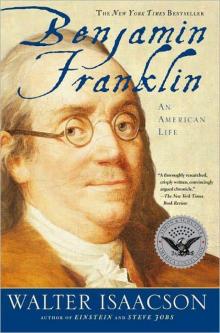 Benjamin Franklin: An American Life
Benjamin Franklin: An American Life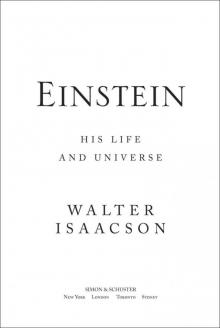 Einstein: His Life and Universe
Einstein: His Life and Universe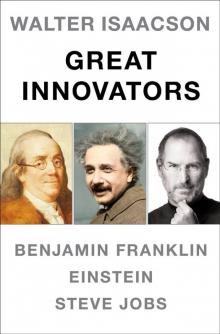 Walter Isaacson Great Innovators e-book boxed set
Walter Isaacson Great Innovators e-book boxed set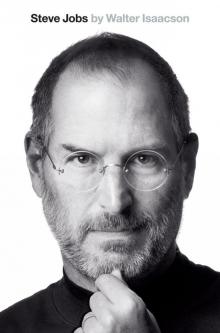 Steve Jobs
Steve Jobs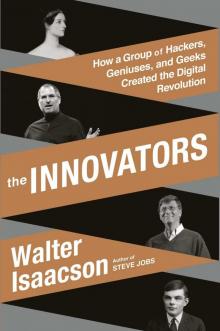 The Innovators
The Innovators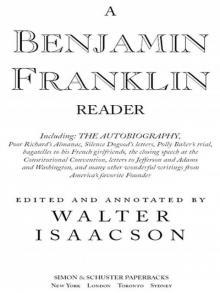 A Benjamin Franklin Reader
A Benjamin Franklin Reader